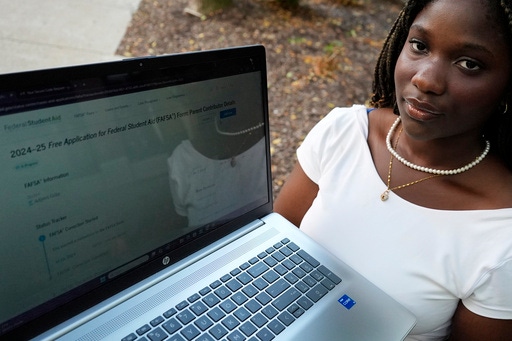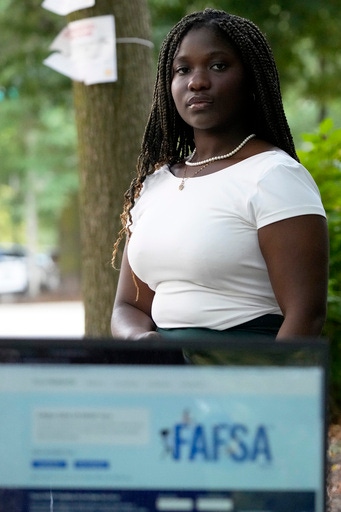Botched college financial aid form snarls students’ enrollment plans

Adjovi Golo holds a laptop at DePaul University in Chicago, Wednesday, Aug. 28, 2024. (AP Photo/Nam Y. Huh)[ASSOCIATED PRESS/Nam Y. Huh]
WASHINGTON (AP) — After a long summer of technical glitches, most of America’s prospective college students finally applied for federal financial aid — an annual process upended by a redesign-gone-bad.
The number of high school seniors who have completed their Free Application for Federal Student Aid is down 9% compared with this time last year, according to the National College Attainment Network. That number was as high as 40% in the spring, when students usually must submit their forms to give schools enough time to assemble an aid package.
How much the FAFSA problems will impact the number of students attending college remains to be seen, counselors and advisers say. But the delays certainly have changed where students enrolled, with many students forced to pick a college with limited information about their financial picture.
As one of the few Black girls at her suburban Chicago high school, Adjovi Golo looked forward to college as a time when it would not be so hard to be seen and heard. She was hoping to attend Spelman College, a historically Black women’s college in Atlanta.
The federal financial aid calculators told her she would likely be eligible for $15,000 in loans, grants and work-study, but her FAFSA had not been processed before a May 1 deadline to commit to a college. She called the FAFSA hotline 11 times to resolve a glitch, getting a different suggestion each time.
DePaul University in Chicago, meantime, offered her the most in merit scholarships. Without a complete financial aid package from either school as her FAFSA remained in limbo, she chose to enroll at DePaul, rather than risk taking on more debt.
In August, Golo moved into DePaul’s dorms. She loves her roommate, the campus and her professors.
But she wonders what might have been different.
“I felt like I was just backed into a corner,” she said. “A part of me, like 75% of me, doesn’t regret it. I love it here. But another part of me wishes I waited.”
The plunge in FAFSA completion rates was especially sharp for students who already face hurdles to enrolling in postsecondary education, including low-income students and students of color. Advocates worry the delays — on top of a Supreme Court ruling that struck down affirmative action in higher education — will affect where and whether many go to college.
Theoretically, said Katharine Meyer, a fellow at the Brookings Institution think tank, “We’re going to see a less racially diverse college enrollment cohort, a less socioeconomically diverse college enrollment cohort.”
Areas with a high percentage of people living in poverty and places with a larger share of Black and Latino residents saw a 20% larger decline in FAFSA completions compared with higher-income areas, according to the Century Foundation, a progressive think tank. Its analysis also found students in those areas were twice as likely to have submitted an incomplete FAFSA.
“It’s too soon to know how bad college enrollment declines will be, but it’s not too early to recognize the risks,” said Peter Granville, a fellow at the Century Foundation.
For students who cannot pay for their entire tuition and fees out of pocket, nearly all forms of financial support — institutional, state and federal, including eligibility for federal loans — require completion of the FAFSA.
A 2020 law directed the Education Department to simplify the FAFSA form, which had been criticized for being tedious and difficult, especially for families without college experience. But the launch of the simplified form in 2023 ran into error upon error — it launched months overdue in December, and students encountered glitches and hours-long waits for helpline assistance.
Emmily Almaraz, a junior at Texas Christian University, said she breezed through the form in under 20 minutes this year. But the students she helped as an intern with Tarrant To & Through Partnership, a college access organization, did not all have the same luck.
Despite spending hours on the phone, one student could not get past the verification process for parents who lack a Social Security number, which is the case for some immigrants. Ultimately, the student decided to delay enrolling until the spring, Almaraz said.
“It’s just really discouraging for certain kids that end up finding out that just because they’re missing one piece of information, it may delay them,” Almaraz said. “It may cause them to pay for an education that they can’t fully pay for.”
College housing became an additional hurdle for students whose families were unwilling to put down deposits without knowing more about financial aid, said Jesse Hendrix, executive director of College Possible Texas. Many were stuck with expensive, off-campus options or could not secure housing at all.
Some students admitted to four-year colleges are choosing more affordable two-year colleges closer to home, counselors say. Chandra Scott, executive director of the nonprofit Alabama Possible, said she reached out to the state’s community colleges urging them to prepare for a last-minute influx of students.
“They’re going to hold out as long as they can, because they may really want to go to that four-year institution,” Scott said. “But if they don’t have the financial aid resources that they need to go in a timely manner, they’re going to have to begin to make hard decisions on whether to sit out a year, which we hope they don’t do.”
Students who don’t continue directly on to college from high school tend to face more barriers to pursuing higher education, counselors and advocates said. While some states have programs to help students return to school, only four in 10 students who do not immediately begin college after high school do so in the next decade, Granville said.
“After you decide to wait a year, that becomes more of a lonely journey,” he said. “That can hinder someone’s likelihood of ultimately completing a degree.”
Some students are still working through FAFSA issues even after enrolling. In Chicago, Golo filed a paper FAFSA in June to try to get a finalized aid package from DePaul, but was told that the agency had a backlog of paper filings. Golo said the school has not required her to start paying until the paperwork is processed.
“I’m kind of just scared to take out money, knowing that I might be able to lower that in a few weeks or so, because I don’t know when it’s going to come,” Golo said of her financial aid package. “It can come tomorrow. It can come in a few weeks. It may not come for a few more months. But my future right now is just very unknown.”
___
The Associated Press’ education coverage receives financial support from multiple private foundations. AP is solely responsible for all content. Find AP’s standards for working with philanthropies, a list of supporters and funded coverage areas at AP.org.
Copyright 2024 The Associated Press. All rights reserved. This material may not be published, broadcast, rewritten or redistributed without permission.
